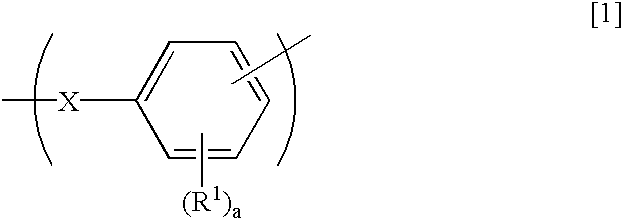Polymer electrolyte membrane and fuel cell
- Summary
- Abstract
- Description
- Claims
- Application Information
AI Technical Summary
Benefits of technology
Problems solved by technology
Method used
Image
Examples
manufacturing example 1
[0107] Manufacturing Example of Polymer Electrolyte (P1)
[0108] Anhydrous cuprous chloride 99 mg, and 2-methyl benzoxazole 266 mg were stirred in toluene 1 ml at room temperature under atmospheric condition for 15 minutes. 2-Phenylphenol 8.5 g and toluene 30 ml were added to the mixture, and stirred at 50.degree. C. under oxygen atmosphere for five hours. Resulting mixture was poured into methanol including hydrochloric acid after completion of reaction, and a polymer was precipitated. The polymer was filtered and dried to obtain poly(2-phenylphenylene ether) (referred to as PE1, hereinafter).
[0109] To a flask equipped with azeotropic distillation equipment Sumika Excel PES5003P (polyether sulfone with hydroxyl end groups, manufactured by Sumitomo Chemical Co., Ltd.) 3.0 g, PE10.75 g, potassium carbonate 0.04 g, N,N-dimethylacetamide (referred to as DMAc hereinafter) 15 ml, and toluene 3 ml were added. Mixture obtained was heated and agitated, and after water was removed off under az...
manufacturing example 2
[0111] Manufacturing Example of Polymer Electrolyte (P2)
[0112] Using same catalyst as manufacturing example 1, using chlorobenzene as solvent, oxidation polymerization of 2-phenylphenol 12.25 g and the 4,4'-dihydroxy biphenyl 1.49 g as monomers was carried out to obtain poly(2-phenylphenylene ether) (referred to as PE2 hereinafter) having hydroxyl groups at both ends.
[0113] Into a flask equipped with azeotropic distillation equipment, Sumika Excel PES5003P 50 g, potassium carbonate 0.36 g, DMAc 180 ml, and toluene 25 ml were added. Under nitrogen, and after heating and stirring were continued for two hours and water was removed under azeotropic condition of toluene and water, toluene was evaporated off. 4,4'-difluoro benzophenone 9.5 g was added, and heating and stirring were continued at 160.degree. C. for five hours. Resultant reaction liquid was pored into a large quantity of methanol, and generated precipitate was recovered by filtration. After resultant precipitate was stirred ...
manufacturing example 3
[0116] Manufacturing Example of Polymer Electrolyte (P3)
[0117] Anhydrous cuprous chloride 99 mg, and N,N,N',N'-tetramethyl-1,3-pro-panediamine 65 mg were stirred in chlorobenzene 5 ml at room temperature under atmospheric condition for 15 minutes. Into the mixture, 2,6-diphenyl phenol 4.43 g, 4,4'-dihydroxybiphenyl 0.37 g, and chlorobenzene 15 ml were added, and the solution was stirred at 60.degree. C. under oxygen atmosphere for five hours. After completion of reaction, the resulting solution was poured into methanol including hydrochloric acid, a polymer was precipitated, and then filtered and dried to obtain poly(2,6-diphenylphenylene ether) having hydroxyl groups at both ends (hereinafter referred to as PE 3).
[0118] Using Sumika Excel PES5003P 8.0 g, PE3 2.0 g, potassium carbonate 0.2 g, 4,4'-difluoro benzophenone 0.26 g, DMAc 50 ml, and toluene 5 ml, the same reaction as Manufacturing Example 1 was conducted to obtain a block copolymer 9.8 g. Resulting block copolymer was sulf...
PUM
| Property | Measurement | Unit |
|---|---|---|
| Fraction | aaaaa | aaaaa |
| Fraction | aaaaa | aaaaa |
| Percent by mass | aaaaa | aaaaa |
Abstract
Description
Claims
Application Information
 Login to View More
Login to View More - R&D
- Intellectual Property
- Life Sciences
- Materials
- Tech Scout
- Unparalleled Data Quality
- Higher Quality Content
- 60% Fewer Hallucinations
Browse by: Latest US Patents, China's latest patents, Technical Efficacy Thesaurus, Application Domain, Technology Topic, Popular Technical Reports.
© 2025 PatSnap. All rights reserved.Legal|Privacy policy|Modern Slavery Act Transparency Statement|Sitemap|About US| Contact US: help@patsnap.com



